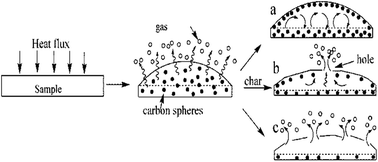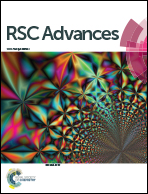Char strengthened by carbon microspheres formed in situ during combustion of IFR/EVA composites catalyzed by solid super acid†
Abstract
Solid super acid (SSA) as a kind of green catalyst was introduced into conventional intumescent flame retardant (IFR)/ethylene-vinyl acetate (EVA) composites to increase their flame retardant efficiency. The IFR used was a combination of ammonium polyphosphate coated by melamine resin (MAPP) and pentaerythritol (PER) with weight ratio at 3 : 1. TGA results showed that the SSA promoted the reaction between MAPP and PER. The thermal degradation temperature of the IFR/EVA composites with 1.5 wt% SSA was significantly increased by 95 °C compared to that of IFR/EVA. The UL 94 V-0 rating can be achieved for EVA composites with 13 wt% total amount of IFR and SSA, while the EVA composites with individual 13 wt% IFR only passed the UL-94 V-2 rating. The char residues at 800 °C of SSA/IFR/EVA composites were 5.8 wt%, which was higher than 2.4 wt% of IFR/EVA composites. Many carbon microspheres were observed by SEM which were deposited in the char matrix after the cone calorimeter test. These carbon microspheres had better graphite structure, thus the char was strengthened and could resist more heat and gas flow erosion. The synergistic effect between the gas phase and condensed phase was considered the main factor for the increase of flame retardant properties.


 Please wait while we load your content...
Please wait while we load your content...